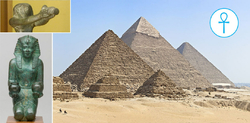- Retour accueil
- Vous êtes ici : Blog The Pyramids of the Cold The Pyramids of the Cold Section 14 • Solvay process : the Red Pyramid
The Pyramids of the Cold Section 14 • Solvay process : the Red Pyramid
Publié par Bruno Coursol dans The Pyramids of the Cold le 12/04/2022 à 20:05
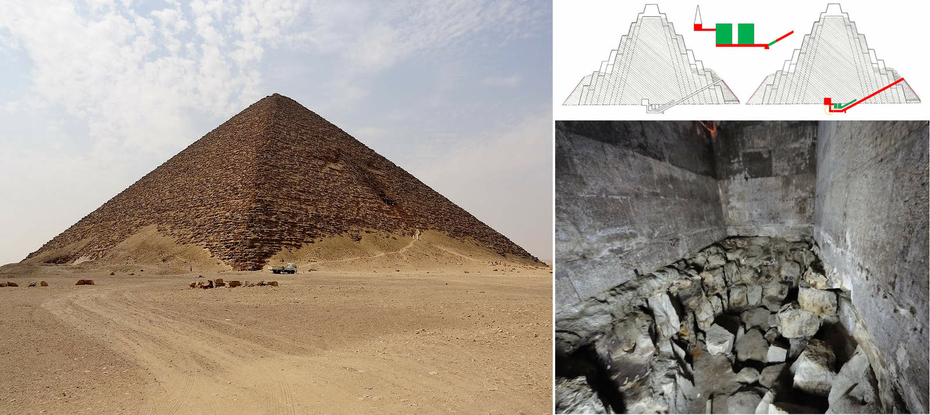
The Red Pyramid at Dashur (left) and the Meidum Pyramid (draws), built by pharaoh Sneferu. What is remarkable in the Meidum pyramid is that it shows a perfect split of the Red Pyramid layout in 2 completely independent sections. The red layout is the energy circuit, from the limestone kiln to the exit of the pyramid. The green layout shows the 2 chemical reacting chambers and the start of the descending passage.
The Meidum pyramid was nothing else than the mock-up of the Red Pyramid's internal layout.
The Pyramids of the Cold - Section 14 • Solvay process : the Red Pyramid
In summary : if pharaoh Sneferu did built 3 pyramids by himself, it is certainly not because of a series of mistakes or change of thoughts. At the time of their construction, the greats pyramids of Sneferu and Khufu were the biggest structures of all times, and they were designed for the exact same purpose than the modern biggest structures of our time : chemical manufacturing.
The very strong ammonia smell and the very particular layout of the "burial chamber" are telling us that the Red Pyramid was designed to manufacture sodium carbonate (the purest mineral form of natron) and sodium bicarbonate, using a Solvay-like ammonia-soda process.
14.01 The typical sodium carbonate plant design in the 1800s (Europe)
It seems that the Meidum Pyramid was a test mockup of the Red Pyramid, where each part could have been tested separately before putting everything together and build a fully functional Red Pyramid.
Actually, the global layout of the Red Pyramid is surprisingly nearly identical to a European sodium carbonate plant in the early 1800s and based on the late 1700s work by the French chemist Nicolas Leblanc. Sodium carbonate is the modern term for natron, the mummification salt used by ancient Egyptians.
For more details about the copy-paste similarities between the Red Pyramid and the 1800s typical sodium carbonate plants in Europe, please visit : http://www.verre-histoire.org/colloques/innovations/pages/p302_01_chopinet.html
In this article, drawings from Figuier are very interesting, because they show the similar layout of the Red pyramid and the 1800s European plants for natron production : 3 adjoining and successive chambers, connected by low ceiling corridors and ended by an exhaust conduct.
But the author also points out that in Europe, the industrial chemistry started with the glass industry.
And the ones who mastered the glass manufacturing process, in the first place, were the Egyptians, 5000 years ago. That is 500 years before Sneferu's reign and the Great Pyramid.
14.02 The Great Sneferu's fourth culmination pyramid at Giza
The quest of the purest natron manufacturing by Khufu's father, explains why Sneferu built 3 complete pyramids. There was no mistake or last minute change of mind, but a very modern technological development program. The Red Pyramid shows they were having difficulties in controlling the temperature of the chemical reaction units and that was the purpose of the Great Pyramid : cold production.
The Great Pyramid was the outcome of Sneferu's research program, in some way it is his fourth pyramid, and the reason this pyramid is so big, is because they had to implement a cold production unit to the initial Red Pyramid layout.
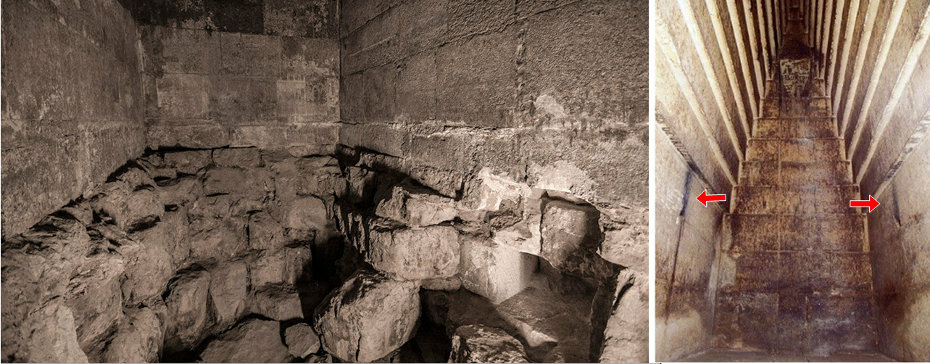
The Red Pyramid of pharaoh Sneferu, with the burial chamber and the hole supposedly digged by robbers (left photograph © Willy Blanchard, September 7, 2014 : https://willyblanchard.ch/egypte-2014-pyramide-rouge/). On the right photograph, the adjoining chamber where dark traces are coming out of opposite holes. These traces had been recently cleaned, as well as all the other traces of the wall, now hidden with modern stairs.
The dark traces indicate that (hot) gases were injected trough these holes into structures that were put into the chamber.
14.03 Solvay process clue n°1 : the ammonia smell of the Burial chamber
On the first photograph of the burial chamber, the blocks have also been recently covered with cement, I assume to reduce the ammonia smell. These stones would have been indirectly highly heated by the furnace of the limestone kiln, they would have get very dry, and when the operating of the Red pyramid was over, I guess all the ammonia got released in the pyramid and these dry rocks would have "sucked in" huge amount of it.
14.04 The over-heating problem : they couldn't cool down the towers
Because of the huge ammonia smell in the Red Pyramid, we know they didn't control the chemical reaction temperatures : the ammonia is indispensable for the Solvay process to work, but the chemical balances of the ammonia cycle, if the temperatures are efficiently controlled, give to this element a minor role : there is about the same amount of ammonia consumed than ammonia produced by the Solvay process.
If huge quantities of ammonia were produced, it is because they couldn't cool down the towers.
The over-heating of the reaction chambers in the Red Pyramid explains why the evaporative cold was implemented in the design of the Great Pyramid of Giza : the known part of the Great Pyramid of Khufu was designed to fix this particular problem, with the horizontal evaporative cooling passage. The cold (between 5°C and 10°C, or 41°F to 50°F), was stored inside the Queen's chamber and then would have been transferred to a Red Pyramid-like natron manufacturing unit, that would still stand today inside the pyramid, waiting to be discovered.
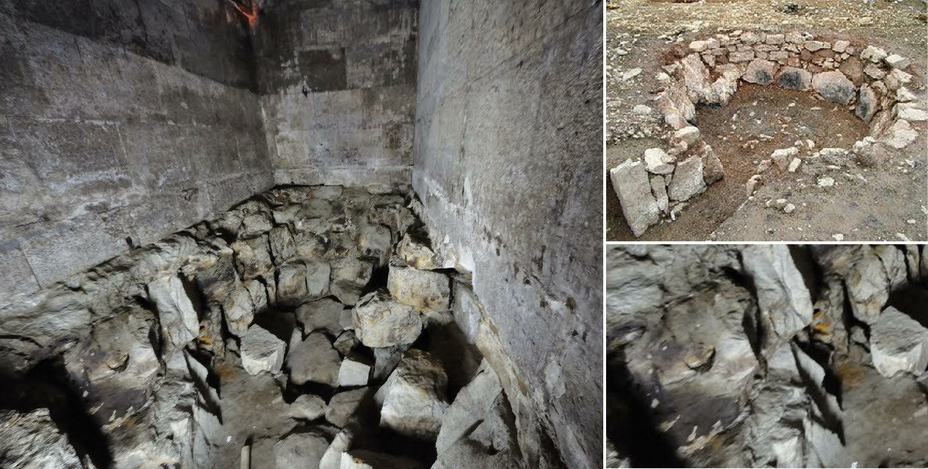
On the left : the "burial chamber" of the Red Pyramid at Dashur, before cement has been poured on the blocks, I presume, in order to reduce the ammonia gas emissions. Image on the right : ancient limestone kiln at Betws yn Rhos, Abergele (Wales, United-Kingdom), thanks to CPAT Clwyd-Powys Archaeological Trust (Recent projects, Llais Afon).
14.05 Solvay process clue n°2 : the burial chamber of the Red Pyramid was a limestone kiln
The burial chamber of the Red Pyramid was actually a limestone kiln : it explains why there is no floor, why the remaining blocks are burnt and laid out in concentric circles, why they are forming a cone shaped hole and why there is a little passage, supposedly digged by robbers.
A limestone kiln is the first step in sodium carbonate manufacturing
Please note, on the above left photograph, the burnt block on the foreground left corner. If you look attentively, you can find such burnt blocks all over the pit.
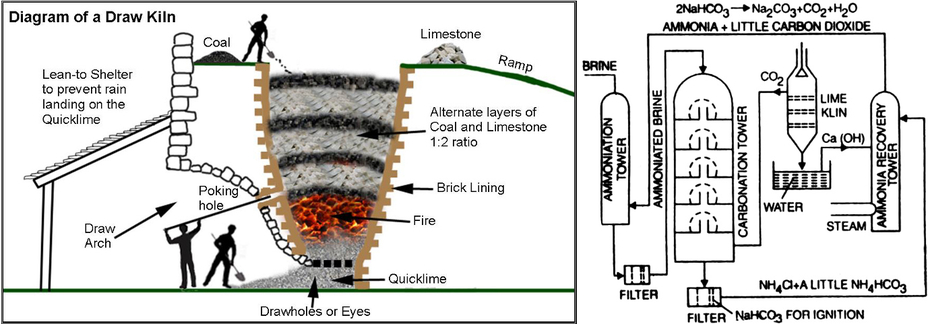
Diagrams of a limestone kiln and the ammonia-soda Solvay process.
https://classnotes.org.in/class11/chemistry/s-block-elements/sodium-carbonate/
14.06 The operating period of the pyramids
Of course, the fact that the burial chamber of the Red Pyramid was actually designed to be a limestone kiln, imply that when the kiln was in operation, the elevation of the pyramid had stopped, exactly like what we've already seen with the Great Pyramid : during the operation period, the pyramids weren't finished to build.
Here, for the Red Pyramid as well as for the Meidum Pyramid, it is even more obvious.
Take the Meidum Pyramid for example, and look in particular the position of the 2 separate layouts : while the chemical reaction chambers of the green layout is completely underground and their ceiling just at floor level, the "burial chamber" limestone kiln of the red layout is completely above floor level, with its floor exactly at the floor level.
What it means, is that these chambers most probably had simply been built with no pyramid around, at the exception of the supporting part on which were put the small and large "descending" passages.
In other words, ancient Egyptians did what they wanted to do on these chambers, this mock-up of the Red Pyramid, and then built the pyramid on top of it.

Left and right : the Meidum Pyramid, built by pharaoh Sneferu. Center : the Red Pyramid at Dashur, by the same king. What is remarkable in the Meidum pyramid is that it shows a perfect split of the Red Pyramid layout in 2 completely independent parts. The red layout is the energy circuit, from the limestone kiln to the exit of the pyramid. The green layout shows the 2 chemical reacting chambers and the start of the descending passage.
14.07 The 2 separate layouts of the Red Pyramid at Dashur
• The limestone kiln layout (red) for lime and CO2 production
The red layout indicates the "energy circuit", from the limestone kiln that was operated inside what is called today "the burial chamber", to the descending passage and the exit of the pyramid. Lime and CO2 were used inside the 2 chemical reaction chambers, through a Solvay-like process.
• The 2 chemical reaction chambers layout (green)
The green layout shows the 2 chemical reacting chambers and the start of the descending passage, where the natron was separated from the steam getting out of the pyramid.
The Red Pyramid is in some way, the most important of all pyramids, because it tells us what was the real goal of the 3 pyramids of Sneferu and the real function of the Great Pyramid of Khufu, his son.
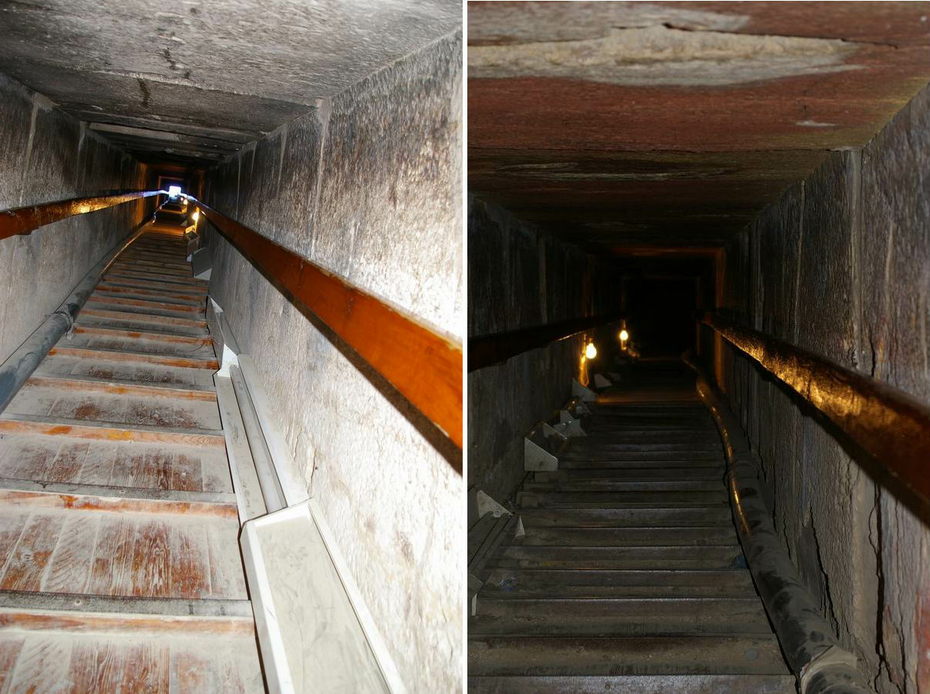
On the left is the lower part of the Red Pyramid descending passage (looking up) and showing only the natural color of the stone blocks. On the right is the same passage (looking down), above the lower section, and showing red and yellow deposits both onto the ceiling and the walls.
The big pipe on the floor is going to the "burial chamber" and is supposed to bring fresh air, or get rid of most of the ammonia smell (I don't know if air is pumped in or out of the chamber).
Where the ceiling has been recently damaged, we can see the natural color of the stone. Red and yellows really are deposits, they are not the natural color of the blocks : some activity inside the pyramid, after the passage was built, was responsible for their presence.
14.08 Solvay process clue n°3 : the red and yellow deposits on the Red Pyramid descending passage
On the left above photograph is the lower part of the Red Pyramid descending passage (looking up) and showing only the natural color of the stone blocks. On the right image, there is the same passage (looking down), but above the lower section, and showing red and yellow deposits both onto the ceiling and the walls.
It is very important to note that they really are deposits : where the ceiling has been recently damaged, we can see the natural color of the stone.
Red and yellow colors really are deposits, they are not the natural color of the blocks : it implicate that some sort of activity took place inside the pyramid, and after the passage was built, and that it was responsible for their presence.
The colors are not decorative paintings either : red and yellows are mingled together in such a way that no artist would have been responsible for it.
The conclusion that these colors are resulting from chemical manufacturing, is inevitable.
14.09 The Disc of Sabu responsible for these red and yellow colors ?
We'll see in the next Section, that one crucial equipment for the ammonia-soda Solvay process is a dome shaped and perforated plate that allows the counterflow reactions between descending brine and ascending gas, to perform in an efficient way, and that it most probably was the real function of the Disc of Sabu.
Interestingly, the schist material in which is made the Disc of Sabu, contains a mineral with a very high concentration of iron : the ferrite. It is possible that the red deposits that are still visible inside the descending passage of the Red Pyramid (mostly on the ceiling), are coming from this ferrite mineral. The heat coming from the limestone kiln CO2 would have extract ferrite iron from discs of Sabu and it would have then deposit itself in the passage, where it would have rust and turn red.
It is still unclear to me where the yellow deposits we can also find in the passage are coming from.
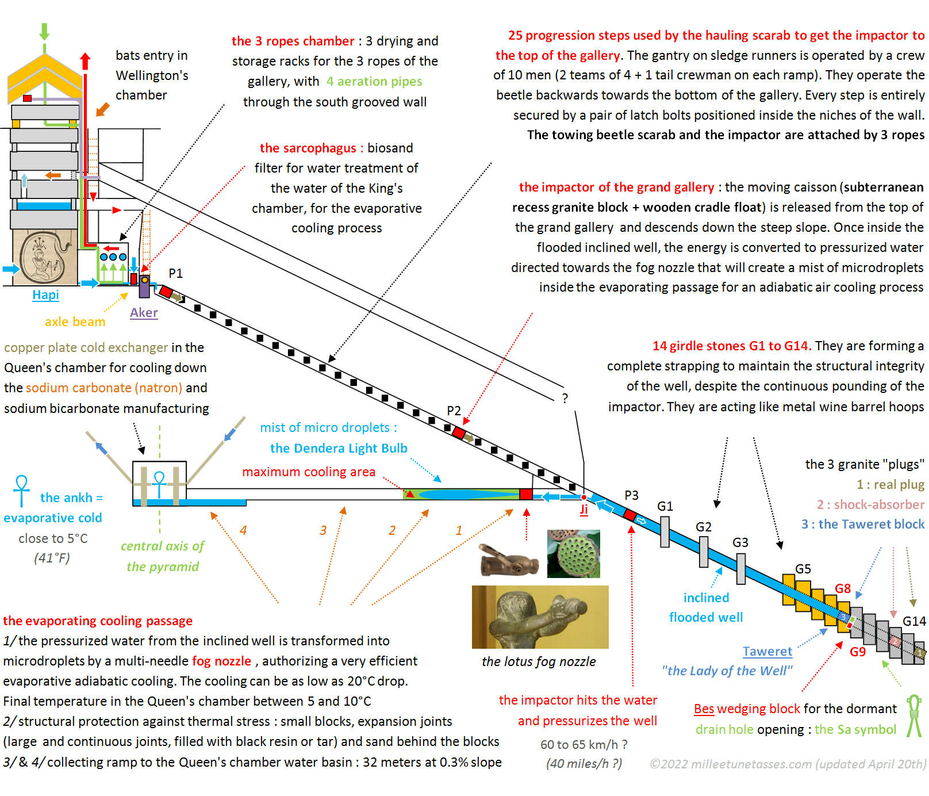
Diagram of the Great Pyramid of Giza in operation, before the shutdown procedure and the draining of the inclined well.
14.10 Summary of the study : hidden behind the academic vision of the ancient Egyptian religion, a vast number of metaphors are describing some of the most advanced science and technological knowledge of that time : ancient Egyptian gods were nothing else than pharaohs' metaphoric self-glorifications of their theoretical and experimental scientific accomplishments in physics and chemistry.
Pharaohs used the power of Science to legitimate themselves as kings of Egypt : they forged an entire religion, based on science to rule their kingdom, and they presented that science as Magic.
The end game of this technological program that probably started on the very first Dynasty, was the Great Pyramid of Giza where evaporative cooling was engineered in the known part of the pyramid from the pressurized water produced in the inclined well, known today as the ascending passage.
The evaporative cold simply took advantage of the power of water, and was most probably necessary to cool down chemical manufacturing of sodium carbonate and sodium bicarbonate produced by an ammonia-soda Solvay process, as suggested by the very strong ammonia smell and the limestone kiln in the so-called burial chamber of the Red Pyramid. At that time, sodium carbonate was called natron, and it was the salt used for the mummification of the pharaohs (Sections 14, 15 and 16).
The cooling seems to have represented the most difficult part of the process, as suggested by the Step Pyramid's official name : according to scholars, the very first pyramid complex, the Step Pyramid of Djoser, was called "the refreshment of the Gods". No doubt that a more accurate translation would certainly be "the cooling of the Gods".
It means that ancient Egyptians were the first civilization to master a Solvay-like process for sodium carbonate manufacturing, long before it got reinvented in the 1800's in Europe. The key elements of that process is the temperature control of the chemical reactions (the cooling), and the dome shaped plate necessary for the counterflow chemical reactions to occur in an efficient way. That counterflow reaction plate is what really is the disc of Sabu.
As shown with Akhenaten and Nefertiti, the creation of the evaporative cold was the most sacred accomplishment of all (Section 17), and this is exactly what the Dendera Light is all about : the Dendera Light is the fog of microdroplets of liquid water that evaporates and creates the cold. Talking about the snake inside the Dendera Light Bulb : "The field surrounding Ra’s snake form is referred to in ancient Egyptian literature as protective magical energy in liquid form that all gods and pharaohs possess" (Faulkner, Section 2).
Everything that had been done in the Great Pyramid of Giza inspired most of the ancient Egyptian religion, and it had been glorified into what we know today as the Underworld.
The Underworld is referring to the chambers and passages of the Great Pyramid of Khufu, and in particular to the Grand Gallery where a hauling gantry beetle operated a wooden coffin shaped impactor that had a small nested granite block inside it. The impactor generated endlessly, over and over, maybe every 15 minutes the pressurized water that was then transformed into a fog of microdroplets inside the horizontal cooling passage.
The Grand Gallery of the Great Pyramid where the act of hauling was done, is the "Secret Hauling Cavern of the Underworld" described in the Amduat "Book of the Hidden Chamber".
The most important chamber of the Great Pyramid wasn't the King's chamber that only was the main water tank of the pyramid, but the Queen's chamber, the only one on the central axis of the pyramid. Because the Queen's chamber was inaccessible from the rest of the pyramid, it was glorified into the "Hidden Chamber of the Underworld" (Section 11), and because the Queen's chamber was the coolest place in the pyramid (about 5°C / 41°F), and with a constant 100% Humidity rate, this chamber was the one where the biggest amount of very hard salt encrustation had been documented by the first explorers of the pyramid in the 1800's and before it had been removed in 1998 by Zahi Hawass (Section 1). Very hard salt encrustation is the signature of the evaporative cooling process, even nowadays.
The most incredible thing is that pretty much everything I've just said, actually appears in one single myth, but it doesn't originate from ancient Egypt : it is the "Churning of the Ocean" Hindu myth that produces the immortal nectar Amrita. The fact is that the endless churning of water that ends up with the production of an elixir that gives eternal life, is exactly what were doing ancient Egyptians in the inclined well : natron was the salt used for the mummification of pharaohs.
Natron gave eternal life to pharaohs, just like the Amrita (Section 19).
Sheryl Crowe
Bravo! I completely concur. Thank you
Poster un commentaire

